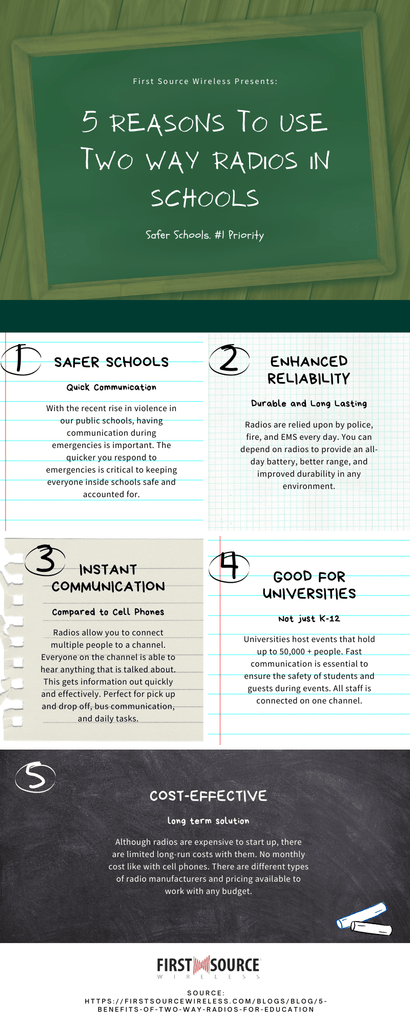Think of all the individuals who are involved in schools. There are students, teachers, professors, staff, administration, janitors, food service, bus drivers and the list can go on. Now think of how you will be able to communicate with all the people in cases of emergencies or just day-to-day activities that help a school function properly.
The first thought in your mind would be to contact them via cell phone. The truth is communicating with just a cell phone won’t do. According to Motorola Solutions, “about 60% say they could be better equipped to handle emergencies by improving K-12 communications.”
There are a lot of ways to two-way radios that can help improve communication throughout our schools. If you're contemplating if two-way radios are a good investment to your school or district, explore these five benefits that will make up your mind.
- Safer schools
- Enhanced reliability
- Instant communication
- Good for universities
- Cost-effective
1. Safer Schools
Unfortunately, there have been 230 school shootings in K-12 since Columbine High School in 1999. There have been 103 in 2018 alone. With the recent rise in violence in our public schools, there is no doubt that schools need to have proper planning before the unthinkable happens. Communication during emergencies is important to consider when planning for such an event. How will teachers and staff be able to communicate with each other? How will they know what is happening outside of their classroom?
There are lots of different situations where a two-way radio can be convenient and fast. If there was an injury during a sporting event, you’re able to call the trainer with a push of a button. Or if there is a fire in the building, evacuating all students and ensuring every teacher has their students out of the building.
The quicker you can respond in any type of emergencies is critical to keeping everyone inside schools safe and accounted for.
2. Enhanced Reliability
Two-way radios are used by police, fire, and ems every day in the most extreme conditions to communicate with their team. Cell phones can have dropped calls, service issues, dead zones and more leaving them with greater concern. When emergencies arise, cell phones can often become unavailable leaving you without communication. Radios have added features that make them reliable to its users like an all-day battery, range, and improved durability.
- All-day battery
- Unlike cell phones that constantly need to be recharged, radios ensure longer battery life. Batteries are used by responders every day who are on the field and don’t have access to charge their battery.
- Range
- You might think that two-way radios don’t have much range and a cell phone would be able to reach better. In certain conditions, these radios range far. Antennas are made to help improve this range, so you get the most out of your radio.
- Improved durability
- You know the moment; you drop your phone and fear picking it back up. You’re hoping your screen didn’t shatter into a million pieces. Two-way radios are known to be durable and allowing them to be used for long periods of time. They are also used in many different environments being used near fire or water.
3. Instant Communications
Different from cell phones, radios allow you to talk to as many people that are on your channel as you want. With cell phones, you can only call one person at a time and if you have a bigger group it can be a while before some people hear of anything happening. Two-way radios give you the ability to communicate in an efficient manner. You don’t have to wait for someone to pick up the call to receive the message
It is illegal to drive a motor vehicle and operate a cell phone. Two-way radios have been approved by the Department of Transportation for use while driving, which is perfect for communication with school bus drivers. This guarantees safe to pick up and drops off with students.
In cases of emergencies, cell phones won’t suffice and responding quickly is the key to safety. If danger happens, cell phones are not the fastest option. You will need to find the appropriate person to call, find their number and wait for them to pick up. With two-way radios, you can communicate with anyone on the channel quickly just by using the push-to-talk button.
4. Good for Universities
Not just public schools can benefit from the use of two-way radios. University's house and host thousands of students each year. Sporting events at state colleges can hold 50,000 people in their stadiums to watch football or basketball games. Communication is essential to ensure every guest is safe while visiting your sports games or campus. The same with public schools, contacting people via cell phones isn’t the fastest way. University campuses have many buildings all around that can span for miles and personnel are always connected when using radios.
5. Cost-Effective
Although radios can be expensive to start up, there is a limited long-run cost associated with them. Unlike cell phones, 2-way radios have no monthly cost to operate. Many schools are experiencing budget cuts that deter public schools from purchasing radios. There are many pricing options that give schools flexibility in how much they want to spend.
There's no doubt that two-way radios are perfect for schools when thinking of the best way to communicate. Although, implementing radios may be expensive students’ safety is a top priority. If emergencies arise having instant communication with your team and emergency personnel is important in giving out valuable lessons that can save a life. Two-way radios are more durable and reliable than cell phones because you’re able to talk to more people at once rather than one at a time. Start thinking today how radios can help your school or university improve communication during emergencies.




